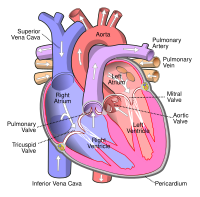
Photo from wikipedia
Aortic stenosis is the most common valvulopathy requiring replacement by means of the surgical or transcatheter approach. Transcatheter aortic valve replacement (TAVR) has quickly become a viable and often preferred… Click to show full abstract
Aortic stenosis is the most common valvulopathy requiring replacement by means of the surgical or transcatheter approach. Transcatheter aortic valve replacement (TAVR) has quickly become a viable and often preferred treatment strategy compared to surgical aortic valve replacement. However, transcatheter heart valve system deployment not infrequently injures the specialized electrical system of the heart, leading to new conduction disorders including high-grade atrioventricular block and complete heart block (CHB) necessitating permanent pacemaker implantation (PPI), which may lead to deleterious effects on cardiac function and patient outcomes. Additional conduction disturbances (e.g., new-onset persistent left bundle branch block, PR/QRS prolongation, and transient CHB) currently lack clearly defined management algorithms leading to variable strategies among institutions. This article outlines the current understanding of the pathophysiology, patient and procedural risk factors, means for further risk stratification and monitoring of patients without a clear indication for PPI, our institutional approach, and future directions in the management and evaluation of post-TAVR conduction disturbances.
Journal Title: Progress in cardiovascular diseases
Year Published: 2021
Link to full text (if available)
Share on Social Media: Sign Up to like & get
recommendations!